Water management at the exterior of homes is critical. Most people know this and I probably sound like a blow-hard when I keep repeating the same message… but too bad. The message bears repeating over and over.
 My latest beef with home builders is poor water management at the exterior of homes, which is mostly about three different things done at the same time: concentrating a lot of water to one location, an anti-gutter policy, and no consideration for gutters in the future. Let me explain.
My latest beef with home builders is poor water management at the exterior of homes, which is mostly about three different things done at the same time: concentrating a lot of water to one location, an anti-gutter policy, and no consideration for gutters in the future. Let me explain.
Concentrating a lot of water to one location
A common design for new houses is to concentrate rain water from several roof surfaces to a small area, which greatly increases the potential for foundation and basement water problems. I marked up the images from some recent new construction inspections to help highlight where a lot of water gets concentrated.
Gutters
Installing gutters would certainly help in all of these situations, but it usually doesn’t happen. Home builders are typically opposed to installing gutters, which is unfortunate. They give poor excuses such as “gutters cause more problems than they fix”, but I suspect the real reason is always about cost savings. Gutters prevent a lot of problems with houses, and they can help in almost every situation. I’ll admit that if a home is properly designed for no gutters, it will function fine without them, but that situation is a rare exception.
Planning for gutters
Even if a builder doesn’t install gutters, it hardly costs any money for them to plan for gutters; all they need to do is toss a twenty foot section of corrugated yard drain at the front of the house, so a downspout can drain under the front walkway.
This never happens though.
Instead, builders do what you see below. Click on the photo below to see a large version of it, so you can really see all of the wood chips washed away. This happened after a very light rain.
After a decent storm this will be a big mess. This was a new construction home in Eden Prairie with nearly a seven figure price tag… and that’s how they dealt with the downspout. In my opinion, the only acceptable fix for this situation is to install a yard drain with a receptor for the downspout; the same thing I blogged about last week. This could have been done very easily with about $5 worth of material before the walkway was poured, but now it’s going to be a much bigger project.
If you’re having a new home built, be sure to cover this stuff early on in the home building process. Even if your builder has a policy saying they won’t direct the downspouts to a yard drain / underground, at least have them bury the tubing for it.
Author: Reuben Saltzman, Structure Tech Home Inspections

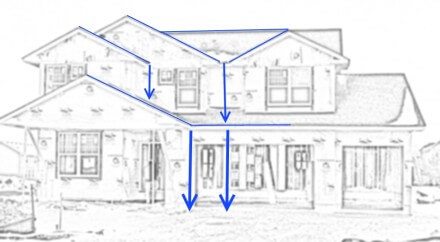
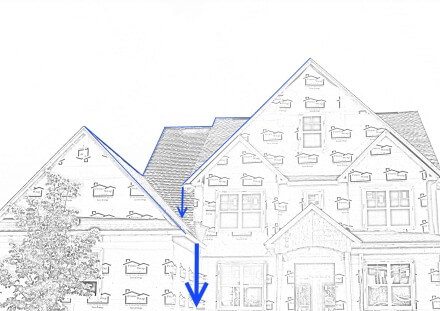
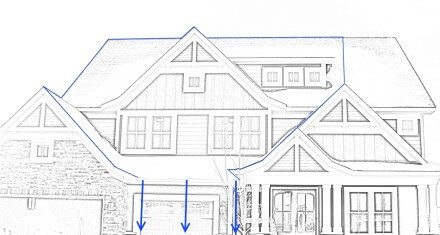
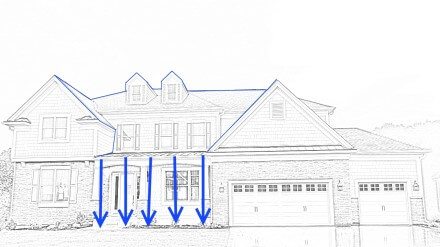
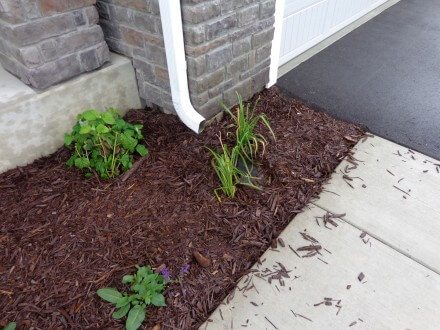
Jeff Carter
August 13, 2013, 8:23 am
Biggest problem with gutters: maintenance. If you have trees nearby, you have to clean the gutters or they are worse than ineffective. Clean them monthly or even weekly. Forever. Can be a real problem. The higher they are, the bigger the problem. If the lot is properly graded, and the roof drainage planned, water dispersal is not a problem. Seems like a better way to go, if you can.
Reuben Saltzman
August 13, 2013, 11:29 am
Hi Jeff – you’re certainly right about keeping gutters clean. The one thing that’s different for new construction is that there are rarely any trees. Every once in a while we’ll inspect a new construction house in an inner-ring suburb where a house was torn down and another built in it’s place, but most new construction homes are in areas with no trees.
Gutters should definitely slope towards downspouts, and they usually do. The slope doesn’t need to be anything dramatic; just enough to prevent water from sitting.
Jeff Carter
August 13, 2013, 8:26 am
And while we are talking about gutters, a question for Reuben: do you think gutters should be pitched to drain to downspout, or? Seems like installers don’t pitch, or even pitch away from downspout. My feeling would be pitch toward downspout, eliminating standing water, but maybe there are other considerations? Thanks for the column and the forum, Reuben.
Glitch Cowboy
September 10, 2013, 7:29 am
I used to clean gutters as a part of my job. I hate gutters passionately. They seem to be clogged more than they actually move water and in my experience even the ‘Guaranteed Super Gutter’ solutions (any and all) aren’t worth their money — Especially after one home that I cleaned: They spent $12k on some Super Gutter and then paid us $75/hr to clean them the next year because they were clogged. So, I’ve thought about this a lot.
Then I bought an old house with no gutters. I rejoiced. And then I cleaned up a wet basement. And then I installed gutters.
I wish there was a cure-all solution for water management and I’m all ears for a better solution.
Mike Baker
September 10, 2013, 8:29 am
Reuben,
Great information! We deal with water management issues A LOT! It seems many homes are built asking for failure whether it be from poor gutter installation or relief, poor grade or poor location of rockbeds/landscaping that allow water to run back at the foundation. Keep up the good work, I always enjoy your blogs and newsletters.
Cougar Land
October 13, 2013, 10:51 pm
1. Sump pumps in cities connect to STORM DRAINS not sewer lines, so don’t know why you talked about that.
2. Regarding the idea of “don’t connect downspouts directly to yard drain”: If their is ice at the end of the line, what does it matter if downspout is directly connected or not? That water is going to back up no matter what to where ever it can get out…and in your case it comes out of the grate next to house. The inspection you did of that house leaking water in shows a problem with the foundation, not with downspouts and yard drains.
Reuben Saltzman
October 14, 2013, 3:47 am
@ Cougar Land – 1. there is no mention of storm drains in this post. I don’t know what you’re referring to.
2. If there is ice at the end of the yard drain and ice backs up a downspout a story, then builds up with ice along the house, it will probably cause problems. The leaking water I showed in different blog post had water leaking in at the deck connection because of a blocked yard drain. This had nothing to do with the foundation.
Cougar Land
October 13, 2013, 10:54 pm
I should have mentioned in #2 of last post…. it’s a problem with the foundation AND the drainage system surrounding the house….
Cougar Land
October 13, 2013, 11:15 pm
One additional thing. If you really want an air gap for a downspout, you can simply install one of those leaf diverter adapters at end of downspout. It has the open area built into the adapter.
Sarah
November 1, 2013, 10:02 pm
Reuben, great site!! Found it searching for deck heave fixes. I had a contractor here today to give me a bid on regrading near a footing that has heaved. Need to fix water issue before we can fix post.
The heaved footing is at the bottom of a sloped hill…we have a walkout and the deck stairs are on the side of the house so the heave is also warping our stairs.
Hubby wants to put in a drain tile that directs water to the drain tile around our foundation. I asked landscaper for bid that directs water away from foundation, so a small retaining wall w a drain tile at the bottom of it leading toward a swale in yard was proposed.
Can you help resolve our unpleasant marital spat? He thinks its ok to channel the water into the foundation drain tile bc it is below our basement floor and bc we have a sump pump. (Which is on the opposite corner of the home). Our home is 5 yrs old.
Thanks in advance for any help you can lend to resolving our fight!
Reuben Saltzman
November 2, 2013, 5:39 am
Hi Sarah, either one of those solutions would probably work. It’s certainly preferable to deal with water at the exterior (your solution), but I’m sure it’s also a lot more money, and dealing with it the way your husband suggested would probably be just fine.